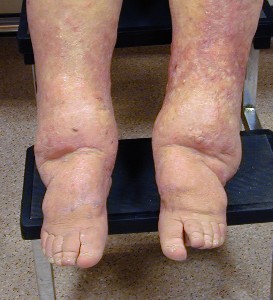Phlebology
Specialty dedicated to lymphatic and venous disorders
Phlebology is a medical-surgical subspecialty within the vascular surgery that involves the study, treatment and prevention of diseases
affecting the venous system. The venous pathology can cause numerous symptoms and signs, the most frequent is heavy legs and the appearance of varicose veins.
Phlebological disorders are very prevalent in our society, affecting both men and women,
More than 50% of the population aged over 50 years could be afected by this disease. There are different manifestations ranging from varicose veins of the legs (venous cord
RAISED dilated and the skin of the legs) to the anti-aesthetic dilations capillaries or spider veins that usually affect thighs and legs. In extremely
advanced stages ulcers and sores may appear on the legs. whose healing is extended in time and can be very disabling
affecting the venous system. The venous pathology can cause numerous symptoms and signs, the most frequent is heavy legs and the appearance of varicose veins.
Phlebological disorders are very prevalent in our society, affecting both men and women,
More than 50% of the population aged over 50 years could be afected by this disease. There are different manifestations ranging from varicose veins of the legs (venous cord
RAISED dilated and the skin of the legs) to the anti-aesthetic dilations capillaries or spider veins that usually affect thighs and legs. In extremely
advanced stages ulcers and sores may appear on the legs. whose healing is extended in time and can be very disabling
Venous system function22

TORTUOSE VARICOSE VEIN

SPIDER VEINS
Varicose veins and spider veins
They can be treated with minimal invasive methods
Varicose veins are a frequent sign of chronic venous failure.
The varicose vein is the result of the dilation or deformity of a vein (blood content drainage duct) located on the surface of the skin. You know you’ve got a case of varicose veins
when the size of this duct exceeds 5 mm in diameter.
When the ducts are smaller, they are reticular veins (from 2 to 5 mm); they are spider veins and telangiectasias if they have a diameter of < 2 mm.
Varicose veins appear in 15% of the population and, a third of these cases have significant discomfort. They are more frequent in women and there is a family predisposition.
Obesity, pregnancy, type of physical activity and physical constitution are other factors that have an influence on this disease.
The varicose vein is the result of the dilation or deformity of a vein (blood content drainage duct) located on the surface of the skin. You know you’ve got a case of varicose veins
when the size of this duct exceeds 5 mm in diameter.
When the ducts are smaller, they are reticular veins (from 2 to 5 mm); they are spider veins and telangiectasias if they have a diameter of < 2 mm.
Varicose veins appear in 15% of the population and, a third of these cases have significant discomfort. They are more frequent in women and there is a family predisposition.
Obesity, pregnancy, type of physical activity and physical constitution are other factors that have an influence on this disease.
Signs , symptoms and different types of varicose veins
BUPA explanation video about varicose veins
TREATMENTS
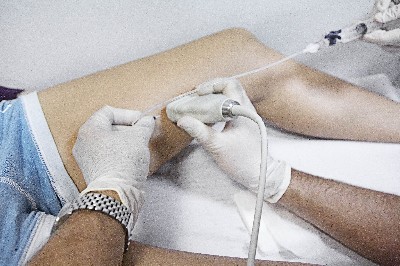
Treatment detail using Duplex as a guide for punction
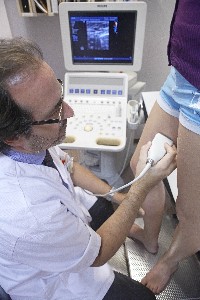
Diagnostic duplex examination
-
FOAM SCLEROTHERAPY
This is a case of making the varicose veins disappear by repeated injections by which an irritating and sclerosing agent is introduced. The significant limitations of the commonly used foam include a set volume and concentration.
Although the use of sclerosis is a very well-known procedure with a long history, the use of products in the form of foam has brought about a significant breakthrough in its results. This foam multiplies the irritating effect of the injected product and, through spasms, helps the faster and more effective occlusion of the vein to be treated. This procedure is extremely useful in the treatment of recurrent varicose veins.
Sclerotherapy using foam is the great revolution in varicose veins and venous malformations treatment. The phlebology of the future will probably include treatment with microfoam: as the safest and least aggressive treatment.
Much more information in www.espumavarices.com
Four steps foam treatment
Ultrasound Guided Foam esclerotherapy explanation
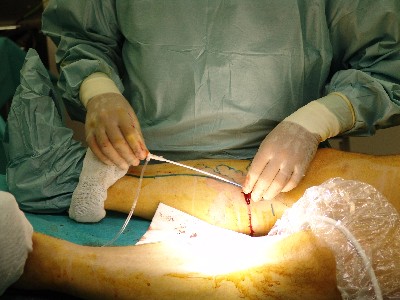
Catheter introduction detail through a minimal incision

Ptient scanning before radiofrequency procedure
-
RADIOFREQUENCY VARICOSE VEINS ABLATION
This treatment is based on applying an ENDOLUMINAL occlusion system (inside the vessel wall) in sclerosis or fibrosis of the interior of the internal or external saphenous vein.
RADIOFREQUENCY is an attempt to prevent the stripping of the internal saphenous vein and they act once the vein has been catheterized (the introduction of a catheter into the inside the vein lumen) and then the catheter releases energy in the form of heat, provoking the burning of its interior, thrombosis of the haematic content and then the withdrawal of its walls. Finally, the vein’s walls collapse and are fibrosed.
This procedure is equivalent to the conventional therapies, although the aggression in this case caused by the stripping of the saphenous vein is avoided along with certain wounds
-
CHIVA CURE
The Cure CHIVA (Conservation hemodynamic Ambulatory Venous Insufficiency), is a surgical technique based on a hemodynamic study by duplex ultrasound of the venous system in lower limbs. CHIVA proposes a strategy to preserve capital venous and preserve the saphenous vein for use if needed in case of bypass.
There are multiple causes of VARICOSE VEINS, but it is accepted that, for them to appear, there must be VALVULAR FAILURE and a DEFECT IN THE CONSTITUTION of the veins that favours their deformation.
The failure of the valves means the venous system is unable to pump blood towards the heart. This causes the blood to stagnate and increases the pressure on the venous walls leading to their deformation and dilation . If on top of this valvular defect the patient is overweight, has a sedentary lifestyle, has (natural or artificial) hormone situations that reduce the venous tone or elasticity or external compression effects, venous hypertension is facilitated and the infamous varicose veins are created.

Pelvic veins that arise from left ovaric vein

Pelvic veins forming a varicose cluster
PELVIC VARICOSE VEINS AND CONGESTION SINDROME
Causes of atypical varicose veins with difficult identification discomfort
Abdominal pain often associated with hormonal changes or heavy legs associated with varicose atypical location (vaginal, vulvar, gluteal hemorrhoids, etc.) Has not received sufficient interest for having overlooked Pelvic venous disease. All these manifestations can relate syndrome ovarian and hypogastric venous insufficiency. Minimally invasive scans can give us accurate diagnosis allows to propose most appropriate therapeutic strategy.
Pelvic congestion syndrome is a frequently misdiagnosed and little known to affect up to 10% of women. It is well known origin and is characterized by the presence of varicose veins ovarian and other veins of the pelvis (hypogastric, pudendal).
Pelvic congestion syndrome is a frequently misdiagnosed and little known to affect up to 10% of women. It is well known origin and is characterized by the presence of varicose veins ovarian and other veins of the pelvis (hypogastric, pudendal).
CONGESTIVE PELVIC SYNDROME
TREATMENTS
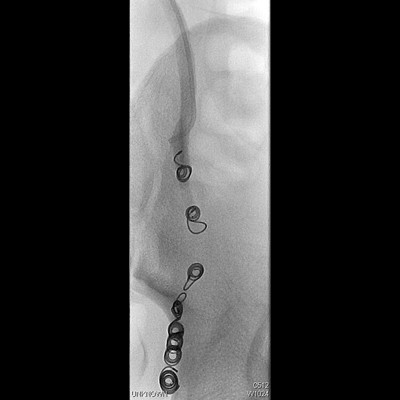
Image of a ovarian vein occludded by coils
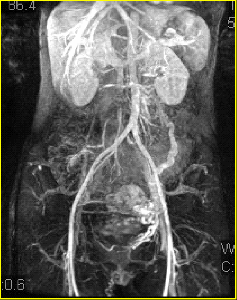
Insuficiency of the left ovarian vein with pelvic varicose veins
-
PELVIC VARICOSE VEINS EMBOLIZATION OR SCLEROTHERAPY
It has proven most effective treatment with varicose veins occlusion or embolization. Sometimes it is desirable to combine different strategies that may include the introduction of "coils" or just tiny wires obstructing pathological veins with injection of sclerosing agents such as polidocanol foam.
Explanation of an ovarian venous Embolization procedure
This syndrome can be associated with varicose veins in the legs or can exist as a isolated discomfort . This is the reason that difficults the diagnosis because there is no external manifestation. Its main symptom is heaviness or pain in the pelvis or in the female genital area. The pain yary in intensity. It is usuall that patient consult various specialists (gastroenterologists, gynecologists, etc.).
Sometimes, because of the difficulty in diagnosis, these patients have come to consult with the psychiatrist for thinking of psychosomatic pain. Other symptoms include pain during sexual contact or urinary discomfort.
The diagnosis is made by minimally invasive studies: transvaginal Doppler ultrasound or magnetic resonance.
Dr. ENRIC ROCHE REBOLLO

Angiologist and Vascular Surgeon. Association member no. 28119
Graduate of the FACULTY OF MEDICINE of the Provincial Hospital Clinico Central University. Resident Locum in ANGIOLOGY and VASCULAR SURGERY GERMANS TRIAS I PUJOL UNIVERSITY HOSPITAL of Barcelona 1993 -1997
Since 1999 to april 2015 was Head of the Angiology and Vascular Surgery Department of the Hospital Plato of Barcelona. Currently is also Medical Director of CLINICA VASCULAR BARCELONA in Barcelona.
Actually in QUIRON GROUP Head of the Angiology ans Vascular Surgery Department of the Hospital Sagrat Cor of Barcelona and Hospital General de Cataluña.
See more
Dr. ANTONI PUIG DOMENECH
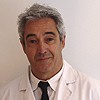
See more

